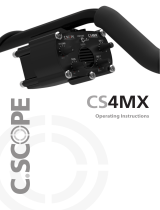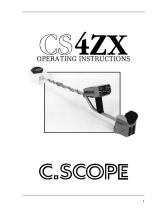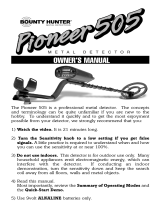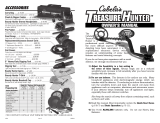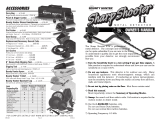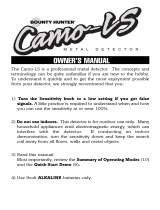Page is loading ...

CS4PI

2
1) Control box mounting clip
2) On/Off/sensitivity control
3) Loudspeaker
4) Signal intensity LED
5) Pulse frequency control
6) Battery compartment
7) 8 x AA battery holder
8) Battery contacts
9) Search-head lead
10) Headphone socke
t
11) Control box
12) Hand grip
13) Upper stem
14) Arm support
15) Detector rest
16) Twist to lock stem length adjuster
17) Lower stem
18) Search-head
19) Search-head fixing screw,
and wing-nut
14
15
13
1
11
12
6
9
16
17
18
19
2
3
4
5
6
7
9
10
1
13
8

3
CS4PI
The CS4PI is a high performance metal detector operating on the
‘PULSE INDUCTION MOTION’ principle.
Optimum performance is achieved by adopting a steady sweep speed.
The CS4PI is an ‘all-metal’ detector which can operate effectively on ground
conditions (notably waterlogged areas or wet salt beaches) where conventional
discriminator metal detectors may be virtually unuseable. The CS4PI is
designed to offer extremely high performance whilst being easy to operate. We
wish you good hunting and a great hobby with the excellent CS4P
I!
Follow these simple steps to start using the CS4PI within minutes . . .
1) Assemble the
CS4PI by inserting the lower stem into the upper stem.
2) Rotate the lower stem so that the search-head cable is coiled around the stem as shown in the photo.
3) Twist the locking device so that the stem is locked into position at the required length.
4) Remove the battery compartment cover by loosening the four retaining screws.
5) Fit 8 x AA batteries to the battery holder being careful to observe polarity and good contact.
6) Switch on and rotate the sensitivity control to the green section marked on the scale.
7) Rotate the Pulse Frequency control to the start of the green zone on the scale. With the search-
head off the ground and well away from any metal object listen for interference. If necessary switch to
a different frequency within the green zone where the detector is silent and interference free.
8) START DETECTING . . . metal targets give an audio signal from the loudspeaker accompanied by
illumination of the LED indicator . . . maintain a steady sweep speed swinging the search-head from
side to side with an easy motion. When you encounter a signal, identify the precise target position by
reducing the width of the sweep arc until it is just a few centimetres either side . . . Keep the search-
head moving.
CS4PI

4
where a background tone is just starting to become apparent. Some detector users prefer to set
sensitivity at a lower level than this so that there is no background tone. (sometimes referred to as
‘silent search mode’).
3) Loudspeaker (and battery condition indicator). The presence of metal is indicated by the
increasing intensity of the loudspeaker tone, accompanied by the LED which illuminates.
4) LED gives visual confirmation of the audio signal.
5) Pulse frequency selector (and battery check position). This control is calibrated in the frequency
of the detection signal (pulses per second). The recommended setting is within the green zone on the
scale. (A metal detector is a type of radio receiver in its principle of operation and may be subject to
interference from, for example, overhead power lines, transmission masts and even other detector
users in the near vicinity. The pulse frequency control gives the possibility to change the operating
frequency to an area free of such interference). Other pulse frequency settings, within the red zone on
the scale, can be used in treasure hunting applications but they tend to be insensitive to thin section
non ferrous objects. As many valuable objects fall into this category, we do not recommend the use of
these frequency settings.
When the battery check switch position is selected (red battery symbol), the
detector will emit an audio tone proportional in length to the condition of the batteries. A tone of 1
- 2 seconds duration indicates good batteries. No tone indicates that the batteries should be changed.
The stem height adjuster should be
slackened to allow the lower stem to
enter the upper stem section. The
search-head lead may then be wound
around the stem as shown in the
photograph. A search-head lead which is
not well secured to the stem could move
about causing false signals. Cable ties
or tape may be used to hold the lead in
position.
When the search-head lead is fitted
correctly, the stem adjusting device can be tightened at a height suitable for the user. Adjust the
position of the search-head so that it is parallel to the ground when the user is in a normal standing
position. Tighten the wing-nut on the search-head retaining screw. Do not over-tighten.
Friction of the head lugs against the neoprene washers keeps the search-head in position.
Excessive pressure on these parts should not be necessary. (If some form of lubricant should ever find
its way onto these washers it will be necessary to disassemble the parts, wash and dry them before
careful reassembly).
1) Control box mounting clip. For ultimate lightweight metal detecting the CS4PI control box can
be removed and fitted to a belt around the body. This leaves only the search-head on the stem which
reduces fatigue on the arm.
2) On/off/sensitivity. Rotary control switches the detector on/off and adjusts the sensitivity.
The area on the scale around the control marked in green is the setting recommended for most
ground target characteristics.
The CS4PI is at its most sensitive with sensitivity adjusted to the point

5
Squeeze the control
box retaining clips
together using your
thumbs a shown in the
photograph.
The control box will
now slide towards you
free of the control box
mounting clip.
The control box can be
fitted to your belt
using
the clip provided. In belt
mounted use be sure to
wind the search-head
cable up the stem at least
to the length adjuster and
secure it with tape or
cable tie.
This is because the
search-head is sensitive to
metal objects above to
some extent and the lead
will be detected if it is left
free to move.
CS4PI
Above: Slide the belt mounting clip into
the fixing slots on the underside of the
control box and push all the way until
the retaining lugs click into position

6
Successful treasure hunting starts with a well researched site.
Sweep the detector head from side to side with a steady relaxed motion. Keep the search-head
parallel and as close as possible to the ground right across the arc of the sweep. The use of a search-
head cover protects the head from abrasion damage caused by friction with the ground.
Search your chosen site carefully by moving forward only the width of the search-head at each
sweep. Move up and down the search area in lines about 75 cms apart so that there is plenty of
overlap in the ground you have covered. Search with the sensitivity set as high as possible according
to the ground conditions. On the majority of inland sites the recommended sensitivity setting
(green
area on the scale) will give the best results. ‘Some severe ground conditions, for example mining
areas containing mineralised deposits, may give rise to false signals and the sensitivity level should be
reduced to a point where detector operation becomes stable.
Some detector users prefer to set the sensitivity control at a point where there is no background
tone, sometimes called ‘silent search’.
(Sensitivity control set around the start of the green zone).
With the detector set like this it is more noticeable when a target signal occurs. If the detector is set
at maximum sensitivity (Sensitivity control set at the end of the green zone) there will be an audio tone constantly
in the background and a metal target will be registered by an increase in the intensity of that tone.
Undo the 4 battery compartment retaining screws and take out the battery holder. Fit 8 good
quality AA type batteries into the compartments of the battery holder. Observe polarity of the
batteries (the spring contact goes against the flat, negative end of the battery). Roll the batteries in
the holder to ensure good contact and replace into the battery compartment with the contacts on the
holder lining up with the contacts in the compartment. Replace the battery compartment cover being
very careful to avoid cross threading the screws. Battery condition can be checked by switching to the
red battery symbol to the left of the Pulse Frequency scale. When the battery check switch position is
selected, the detector will emit an audio tone proportional in length to the condition of the batteries.
A tone of 1 - 2 seconds duration indicates good batteries. No tone indicates that the batteries should
be changed. (After the battery check procedure the detector continues to ‘beep’ about every 8
seconds if the switch is left in the battery check position. This is just a reminder to you to switch off).

7
CS4PI
The CS4PI is a robust design, however the control box should be treated with similar care as
any electronic product. Dry off any water splashes immediately. The search-head may be immersed
in water. Stem and search-head parts should be cleaned and dried at the end of a day’s detecting.
Do not use solvents. If the detector has been used on a beach it will be necessary to wash sand
and salt residue off the stem adjustment mechanism and the search-head retaining parts using tap
water. Remove batteries if the detector is going to be stored for any length of time. Do not open the
controlbox front panel. There are no user serviceable parts inside and you may invalidate your warranty.
Your CS3MX is guaranteed free of manufacturing defects as confirmed in our written warranty
document. Contact us if you have any concerns about the operation of your detector.
The C.SCOPE Customer Service Team really know about metal detectors and are always ready with
good advice and rapid after-sales-service.
We recommend a pulse frequency setting within the green zone on the control scale. It may
be necessary to change to a different pulse frequency to avoid interference from extraneous signal
sources. Experimentation with different metal targets will show you how the pulse frequency can
affect sensitivity to different metals.
When the detector gives a signal, move the search-head to the approximate area where the
signal was heard, and reduce the arc of your sweep so that the search-head is just passing back and
forth a few centimetres either side of the signal. In this way you can identify the exact target position.
(The most sensitive part of the search-head is below its centre). Dig a neat hole by cutting around the
signal position with a sharp edged trowel and remove a divot of earth which might now contain the
metal object. Run the detector over the area again to see if the metal object is still in the hole or in
the piece of earth which you have just removed.
Dig some more and sift through the earth until you find what you are looking for. Fill in the hole
before moving on. (recovering finds in sand is very much easier with a sand scoop - a trowel like a
sieve where the sand is able to run out leaving the find in the scoop).
The use of headphones will increase battery life and make it easier to discern faint signals.
Follow the ‘Country Code’. Do not trespass. Do not touch anything you suspect might
be live ammunition - inform the police. Do not take your detector on any scheduled historic
site. If you find anything which looks like it could have historical significance, report it to
your local museum.
Acquaint yourself with any laws relating to the use of metal detectors if you want to go
detecting in countries other than the UK.
C.SCOPE is an ISO 9001 Quality Manufacturer.
This equipment conforms to the EMC directive
89/336/EEC.
System performance may be impaired by
unusually strong electromagnetic fields.

C.SCOPE INTERNATIONAL LTD
KINGSNORTH TECHNOLOGY PARK
WOTTON ROAD ASHFORD
KENT TN23 6LN UK
Telephone: 01233 629181
Fax: 01233 645897
email: [email protected]
internet: www.cscope.co.uk
/

